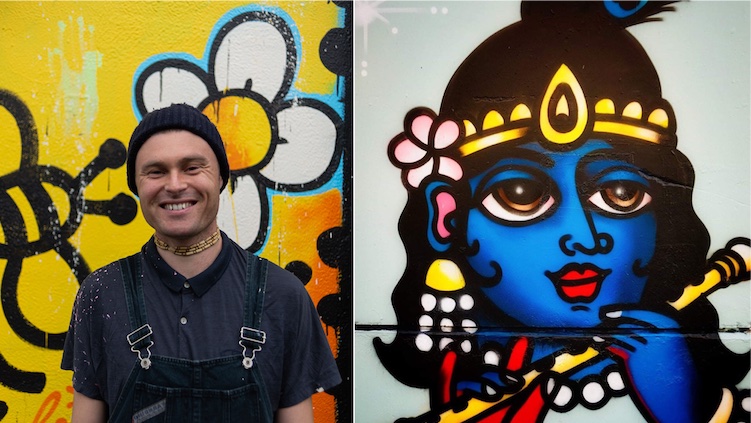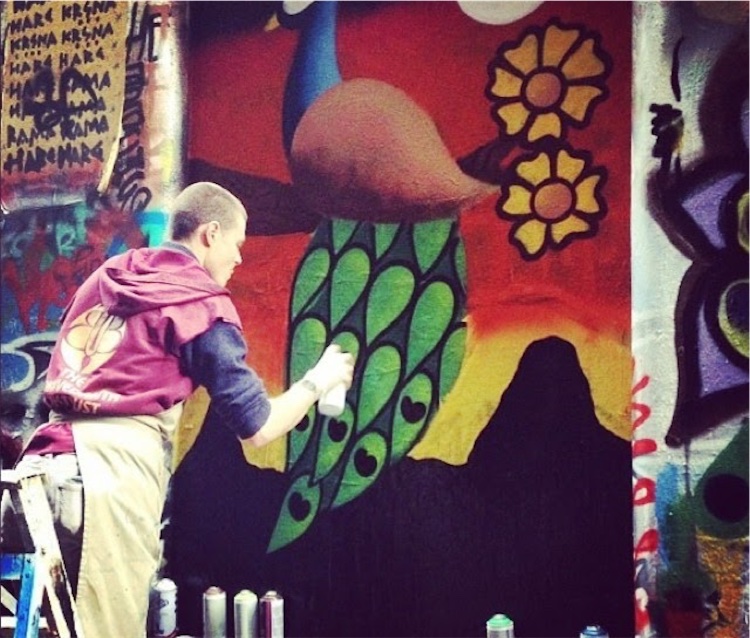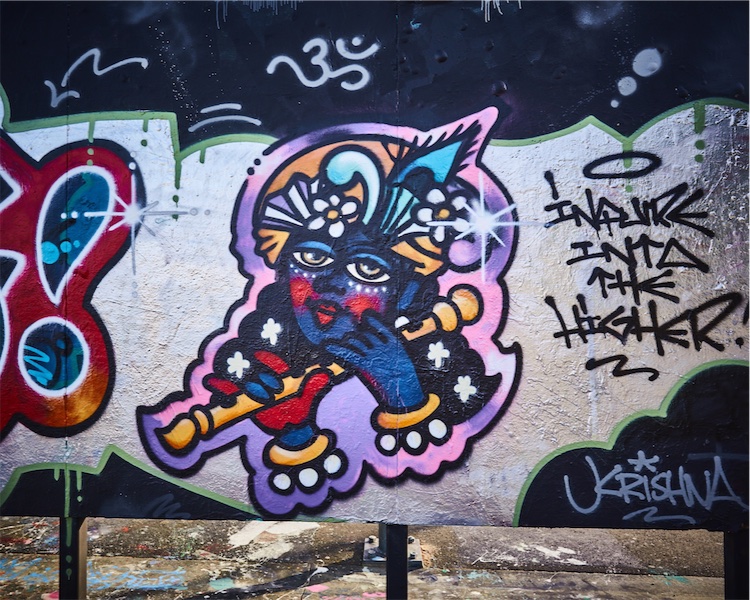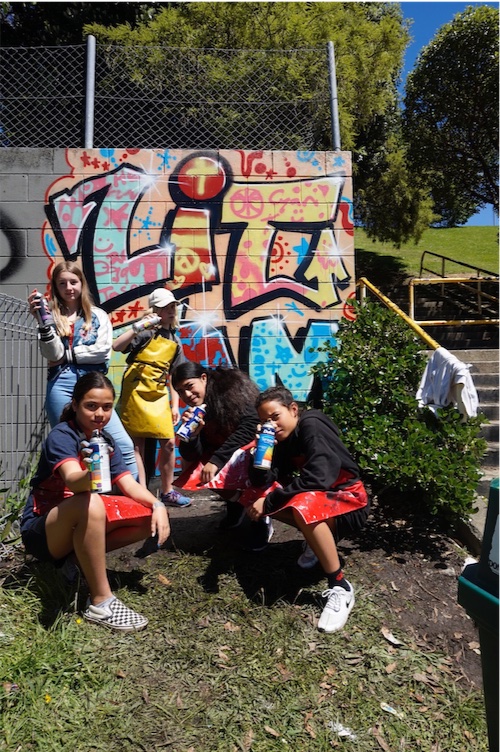Devotee Graffiti Artist Brings Positive Influence to Youths’ Lives
By Madhava Smullen | Янв 31, 2020

When 13-year-old Josh Menheere first noticed graffiti around the surf town where he grew up in Queensland, Australia, and learned techniques from his cousin who was dating a graffiti artist, he didn’t know that one day his own street art would spread spiritual consciousness and positively influence other kids’ lives.
Then, at age 17, an uncle introduced him and his family to Hare Krishna devotees Gunarnava Das and his wife Vishalini Dasi, Prabhupada disciples who ran the Govinda’s restaurant in Coolum.
At the time, Josh and his mother had a fractious relationship, and so she approached Gunarnava, a professional counselor, to help her son.
“Gunarnava Prabhu asked me to assist him on his art project about young people’s values and beliefs,” Josh, now Muchukunda Das, recalls. “He would ask me questions about my own, as well as about my interests in music and skating, and we’d take prasad together. Because he showed so much interest in me, I wanted to ask questions in return. So I asked him about Krishna consciousness. The answers he gave me were so immediately satisfying, that I didn’t need to doubt or ask any further.”
Josh began identifying as a Hare Krishna. By now an established street artist, he changed his graffiti “tag” from his skatecrew’s “JMJ” to the word “Veda,” which he felt better reflected his new ethos.
By his eighteenth birthday, in 2008, Josh had moved into the working men’s ashram at Atma Yoga in Brisbane, an outreach center run by disciples of Devamrita Swami. Serving at the local Govinda’s to pay his rent, he continued doing graffiti in his distinctive pop-art style, which was evolving into even more spiritual subjects such as Lord Krishna and Jagannath’s smiling face.

A devotee boy learns to spray Lord Jagannath graffiti style at one of Muchukunda’s ArtJam workshops
He also continued his immersion in Krishna consciousness, spending hours a day doing Harinama, and especially distributing Srila Prabhupada’s books.
“I loved it so much that I would go out on book distribution, then on my way home, instead of getting off the train in my suburb, I’d get off a station or two early and walk home doing books door to door,” he says. “It was such an ecstatic time in my life.”
Now initiated by Devamrita Swami, Muchukunda Das, 29, is living in Wellington, New Zealand, studying for a Bachelor of Youth Development, and working professionally with organizations that help underprivileged and troubled youth. Inspired by Gunarnava Das, who was such a positive influence in his own life, he hopes to pay it forward and make a difference for others.
With his small business ArtJam, he offers street art workshops to youth interested in graffiti culture, guiding them towards positive art rather than destructive vandalism, and teaching skills that people will pay for. Most importantly, he aims to support young people in their transition from adolescence to adulthood, making sure that those with difficult lives get to have fun and a chance to “just be kids” along the way.
As far as Krishna consciousness goes, Muchukunda doesn’t “preach,” but rather advertises its effects by trying to be an excellent role model while wearing his Hare Krishna identity on his sleeve, as taught by his guru Devamrita Swami.
In this way, he plants many seeds. Sometimes, however, the results are more instant.

Muchukunda at work
“One twelve-year-old who came along to ArtJam told me that he had become a vegetarian, stopped bullying, and started meditating every day,” says Muchkunda. “He often surprised me by saying ‘Krishna.’”
Ocasionally, Muchukunda is able to bring Krishna consciousness more directly into his work. At Victoria University in Melbourne, he offered ten weekly art workshops themed around issues young people face such as belonging, community, and authenticity – and provided useful tools from the Bhagavad-gita and Bhakti-Tirtha Swami’s books.
“That was one of the highlights in my youth career so far,” he says. “I have also taken kids to distribute prasad to the homeless, and parents have appreciated the positive perspective I’m giving their children.”
Muchukunda has also worked with devotee youth, doing a workshop with their Australian bus tour, and creating a beautiful mural for the Hare Krishna School in Auckland with students and teachers.
“I’d like ISKCON youth to grow up feeling like their Krishna conscious upbringing was fun and satisfying – so that’s what I’m hoping to contribute,” he says.
In his spare time, Muchukunda continues to do graffiti art at skateparks and other public locations, where he also makes an impression. Once, a skater approached him while he was painting a picture of Krishna, and asked questions, saying he “would love to read a book about it.”

Krishna graffiti
On another occasion, a woman told him that his art had reminded her of God many times on her way to work, commenting that he was “making the ineffable accessible to people, and making God cool.”
A number of influential artists in the street art community also follow Muchukunda’s work, and have expressed appreciation of his art and its ideas, and interest in Prabhupada’s books.
“Many graffiti artists have collaborated with me and even painted Krishna’s names,” he says. “Some have a bunch of my paintings in their bedrooms, which means they are seeing His name daily.”
Outside of his art and professional work, Muchukunda works with young people at Wellington’s Bhakti Lounge, also a Devamrita Swami project, by reading them Bhagavad-gita, teaching them japa, and taking them on Krishna conscious camping trips.
“That’s my most meaningful and important work,” he says. “Without any formal training, the devotees at the Bhakti Lounge are doing the perfection of youth development – helping youth get connected with the supreme, act in harmony with His will and ultimately achieve His complete mercy. The motto at the Bhakti Lounge is “we make it easy” (to come to Krishna consciousness, to grow in Krishna consciousness and to share Krishna consciousness with others) and their expertise in doing that has transformed the lives of so many youth just in the last four years I’ve lived in Wellington.”

Some of the youth Muchukunda works with
In the next couple of weeks, Muchukunda is set to move to Auckland, where he will use his artistic skills to help at The Loft, another Bhakti-Lounge-style project, by creating posters and comics for its social media and offering spirituality-focused art therapy retreats.
Professionally, he will be working with Zeal, an organization that helps youth discover, express and develop their unique creativity.
“They’ve given me a lot of creative freedom to do my own projects, so we may potentially be able to get funding for Hare Krishna youth to do creative projects in the public space,” he says.
After his studies, he hopes to get a job as a youth worker at a school, supporting people in their transition from youth to adulthood. “I think if a spiritual person can play that role for a young person there’s a high chance they will develop a spiritual outlook on life.”
As far as his art is concerned, Muchukunda says, “What used to drive me was fame. Now it’s the feeling I get when Krishna gives me intelligence how to increase His fame, and when people take interest in Bhakti from contacting my art.”
He explains: “I like to think that doing Krishna art in public space puts Krishna out there in a different way. There was a time when Christians pervaded the arts, and that contributed to the polularity of Christianity today. If Krishna conscious persons can place themselves in different circles such as martial arts, acting, politics, acedemia, music, public art, yoga, cuisine etc, we can effectively transform the way people relate with Krishna. People are driven by fear of new things and desire for new things. By adding Krishna to things people already know, we can make Bhakti easy and palatable.
“So my message is: be yourself, and make your contribution to the mission.”
* * *
To see more of Muchukunda’s work, visit: http://muchu108.com/















